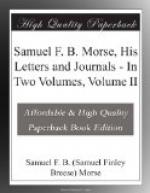After his graduation from Yale College in the fall of 1810, Finley Morse returned to his home in Charlestown, Mass., and cheerfully submitted himself to his parents’ wishes by entering the bookshop of a certain Mr. Mallory.
He writes under date of October 31, 1810, to his brothers who are still at college: “I am in an excellent situation and on excellent terms. I have four hundred dollars per year, but this you must not mention out. I have the choice of my hours; they are from nine till one-half past twelve, and from three till sunset.”
But he still clings to the idea of becoming a painter, for he adds: “My evenings I employ in painting. I have every convenience; the room over the kitchen is fitted up for me; I have a fire there every evening, and can spend it alone or otherwise as I please. I have bought me one of the new patent lamps, those with glass chimneys, which gives an excellent light. It cost me about six dollars. Send on as soon as possible anything and everything which pertains to my painting apparatus.”
The following letter was written at some time in 1810 or 1811. It was addressed to Mr. Sereno E. Dwight:—
“Mr. Mallory a few days since handed me a letter from you requesting me, if possible, to sketch a likeness of young Mr. Daggett. Accordingly I have made the attempt and take the present opportunity of forwarding you the results. The task was hard but pleasurable. It is one of the most difficult undertakings to endeavor to take a portrait from recollection of one whose countenance has not been examined particularly for the purpose. When I made the first attempt, not a single feature could I recall distinctly to my memory and I almost despaired of a likeness, but the thought of lessening the affliction of such a distressed family determined me to attempt it a second time. The result is on the ivory. I then showed it to my brothers, to Mr. Evarts, to Mr. Hillhouse, to Mr. Mallory, and to Mr. Read, all of whom had not the least suspicion of anything of the kind, and they have severally and separately pronounced it a likeness of young Mr. Daggett. This encouraged me, and I made the two other sketches which are thought likewise to be resemblances of him.
“If these or any one of them can be recognized by the afflicted family as a resemblance of him they have lost, it will be an ample compensation to me to think that I have in any degree been the means of alleviating their suffering....”
On December 8, 1810, he writes to his brother: “I have almost completed my landscape. It is ‘proper handsome,’ so they say, and they want to make me believe it is so, but I shan’t yet awhile.”
This shows the right frame of mind for an artist, and yet, like most youthful painters, he attempted more than his proficiency warranted, for in this same letter he adds: “I am going to begin, as soon as I have finished it [the landscape], a piece, the subject of which will be ‘Marius on the Ruins of Carthage.’”




